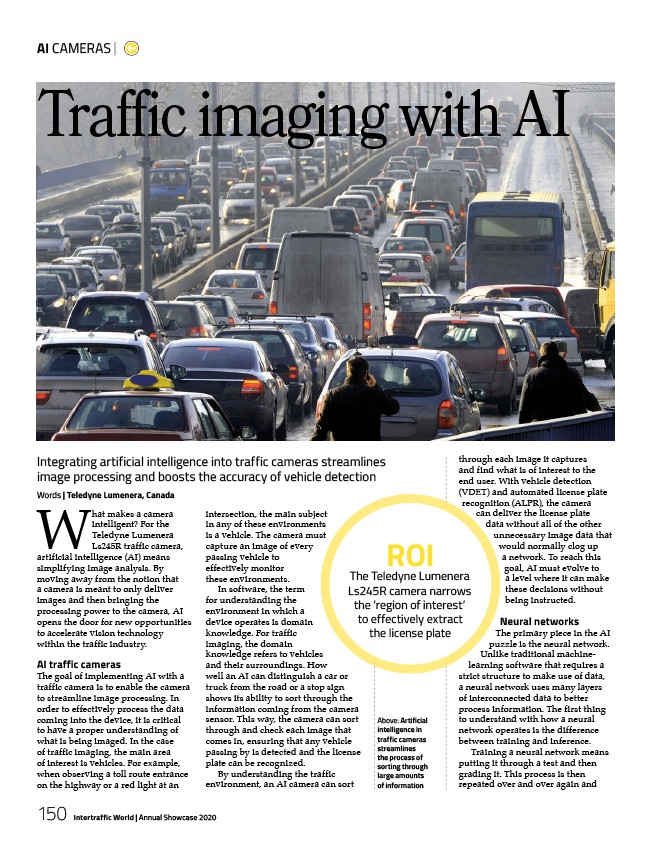
AI CAMERAS |
Traffic imaging with AI
Integrating artificial intelligence into traffic cameras streamlines
image processing and boosts the accuracy of vehicle detection
Words | Teledyne Lumenera, Canada
150 Intertraffic World | Annual Showcase 2020
ROI The Teledyne Lumenera
Ls245R camera narrows
the ‘region of interest’
to effectively extract
the license plate
Above: Artificial
intelligence in
traffic cameras
streamlines
the process of
sorting through
large amounts
of information
What makes a camera
intelligent? For the
Teledyne Lumenera
Ls245R traffic camera,
artificial intelligence (AI) means
simplifying image analysis. By
moving away from the notion that
a camera is meant to only deliver
images and then bringing the
processing power to the camera, AI
opens the door for new opportunities
to accelerate vision technology
within the traffic industry.
AI traffic cameras
The goal of implementing AI with a
traffic camera is to enable the camera
to streamline image processing. In
order to effectively process the data
coming into the device, it is critical
to have a proper understanding of
what is being imaged. In the case
of traffic imaging, the main area
of interest is vehicles. For example,
when observing a toll route entrance
on the highway or a red light at an
intersection, the main subject
in any of these environments
is a vehicle. The camera must
capture an image of every
passing vehicle to
effectively monitor
these environments.
In software, the term
for understanding the
environment in which a
device operates is domain
knowledge. For traffic
imaging, the domain
knowledge refers to vehicles
and their surroundings. How
well an AI can distinguish a car or
truck from the road or a stop sign
shows its ability to sort through the
information coming from the camera
sensor. This way, the camera can sort
through and check each image that
comes in, ensuring that any vehicle
passing by is detected and the license
plate can be recognized.
By understanding the traffic
environment, an AI camera can sort
through each image it captures
and find what is of interest to the
end user. With vehicle detection
(VDET) and automated license plate
recognition (ALPR), the camera
can deliver the license plate
data without all of the other
unnecessary image data that
would normally clog up
a network. To reach this
goal, AI must evolve to
a level where it can make
these decisions without
being instructed.
Neural networks
The primary piece in the AI
puzzle is the neural network.
Unlike traditional machinelearning
software that requires a
strict structure to make use of data,
a neural network uses many layers
of interconnected data to better
process information. The first thing
to understand with how a neural
network operates is the difference
between training and inference.
Training a neural network means
putting it through a test and then
grading it. This process is then
repeated over and over again and